Sarah Lipstate – Crafting Cinematic Soundscapes with Guitars, Bows, and Pedals Galore
by Barry Cleveland
Sarah Lipstate—whose nom de plume is Noveller when performing solo—describes her music as “cinematic guitar soundscapes.” In concert, she conjures those soundscapes from a vast array of effects pedals and a multi-channel looper, with the aid of a cello bow, various other bowing devices, and extended playing techniques. In the studio, Lipstate taps the magic of modern recording and sound design capabilities to further enhance her sonic creations.
In addition to releasing more than a dozen albums of her own music and scoring several films, Lipstate has toured as the opening act for luminaries such as St. Vincent and Iggy Pop, as well as being a member of Pop’s band and collaborating with the legendary vocalist on three pieces from his Free album. She also performed in guitar ensembles led by avant-garde composers Glenn Branca and Rhys Chatham while still in school, where she studied filmmaking.
Lipstate’s primary instrument is a Fender American Professional Series Jazzmaster with Chicago Special pickups and a Mastery bridge, but she also plays numerous other guitars including a Fender Ed O’Brien Sustainer Stratocaster fitted with a Gizmotron mechanical bowing device, Yamaha Revstars, and a custom Bilt Relevator + Effects with onboard fuzz, reverb, and delay. Her expansive stompbox collection boasts everything from ultra-rare vintage pedals to bleeding-edge modern masterpieces. Lipstate’s artwork graces the Keeley Sarah Lipstate Loomer fuzz/reverb pedal and she co-designed the handcrafted Moon Canyon overdrive/reverb/delay pedal with Dutch pedal builder Dr. No.
Lipstate also crafted a unique Artist Preset for the Line 6 HX Effects processor (also compatible with HX Stomp and Helix amp and effects processors), featuring multiple distortions, multiple delays, and the Searchlights reverb. Download the preset below.
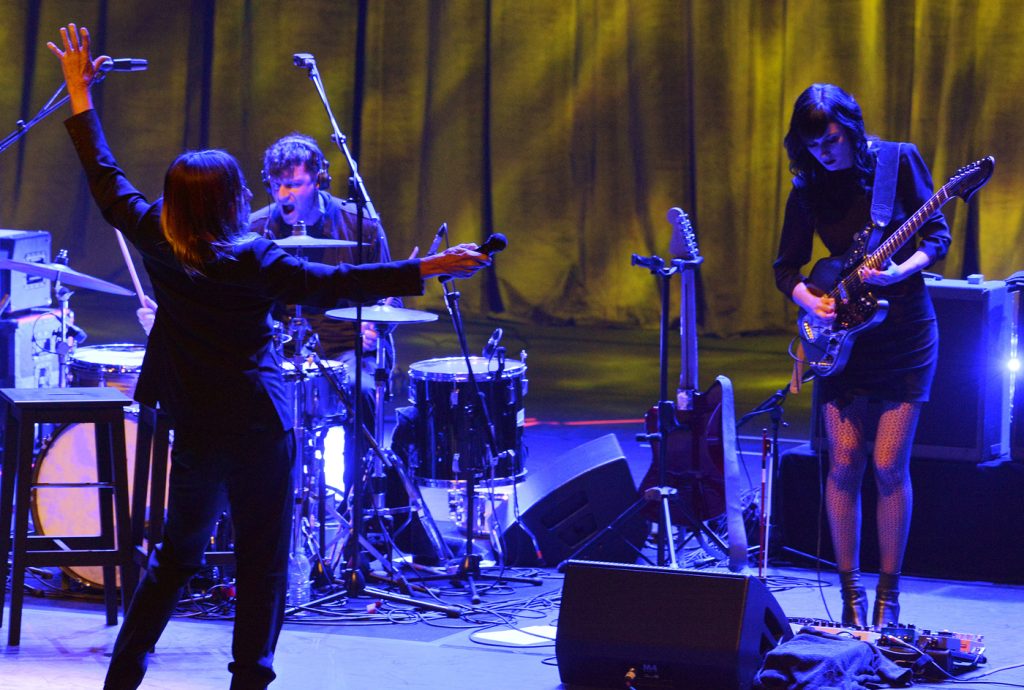
Lipstate performing with Iggy Pop at the EFG London Jazz Festival, November 21, 2019.
What’s the story behind the name Noveller?
While in college I had a duo project called One Umbrella and my partner thought it would be great if we performed using aliases; he became “Quebron” and I became “Novella,” a short novel. I chose it just because I thought it was a beautiful word and it spoke to me. Then, when I needed a name for a solo project I thought, “Well, I’m Novella in this project, so I can be Noveller.” There was not a lot of thought put into it other than that. So now, years and years later, I’m living with that [laughs]. People don’t know how to pronounce it because although novella is an actual word, noveller is not.
What did you take away from your experience playing with Glenn Branca?
I was 20 years old and still in college when I was accepted to play in the Branca Ensemble and it was a life-changing experience. Instead of preparing for my semester work I was entirely focused on studying the score and working on the music. Then, flying out and being part of the rehearsals was amazing, and the performance itself felt really beautiful and transcendent. The experience also helped me dial in to the way my brain is wired, and to understand that sonic qualities such as dissonance and tension really appeal to me and go straight to my heart.
Shortly after that you also had the opportunity to play with Rhys Chatham.
Yes, with a sextet at the Table of Elements Festival in Atlanta, performing Guitar Trio. It was a very different experience because the group was so much smaller, and the music was also quite different than Branca’s Symphony No. 13. I asked for a copy of the score to study and they laughed and said that I would basically just be playing an E chord the entire time. The focus was on the harmonic overtones and everything that comes out of the repetition and the rhythmic changes that occur while playing essentially a single chord. One difference between that experience and playing with Glenn was that I didn’t really have one-on-one time with him given the size of the ensemble, whereas I did with Rhys, and I went on to perform with him four or five more times after that and to develop a relationship.
Noveller performing “Gathering the Elements” at Royal Albert Hall May 13th, 2016.
Sonic Youth was a big early influence as well.
I got my first guitar while I was in high school and at that time I was really steeped in Sonic Youth’s music. I had the Goo music video, the 1991 – The Year Punk Broke documentary, the Screaming Fields of Sonic Love compilation album and other records, and I watched and listened to them over and over. I think the thing that most interested me was that they played in lots of alternate tunings, so when I got my first guitar, I just moved the tuners around until I found tunings that sounded cool to me, which meant they had a kind of dissonant sound. I had a cheap Dan Electro guitar and a Dan Electro Dirty Thirty practice amp, but no pedals, and I was frustrated that they were able to create all of this beautiful feedback and I wasn’t, so I wanted to learn how to do that. The tunings helped me approximate the same feel to the extent that I was able to, and they are what I wrote all of my music in until a few years ago when I began playing in standard tuning.
Also, I had spent many years of my life studying piano and trombone and being successful at those, but there was so much pressure associated with piano competitions and being the first chair trombonist that it kind of sucked the life and joy out of music for me. Sonic Youth had this punk attitude and it seemed like they were playing music that made them feel happy and excited—and that’s what I wanted for myself. I wasn’t trying to play their songs, I just wanted to follow that approach to my instrument.
Though you had studied music and music theory previously, which also informed your musical approach?
Yes, but I really tried to throw all that out the window with guitar. I didn’t want those structures to be imposed on this new instrument. With the guitar I’m very much an intuitive player. If I start feeling excited or inspired or joy or sadness or any kind of strong emotion, it’s just like, “Yes, more of that, I’m going down the right path.” With piano and trombone, it was always getting to a point where I could competently play some great master’s composition. And that’s great. But that’s entirely different from what I’m trying to do for myself. I want to make my own music and I want it to be something that feels true to me.

When did your fascination with effects pedals begin?
My very first pedal was an Ibanez TS7 Tube Screamer, and then later I had a board that also included a Boss DD-6 Digital Delay, a Moogerfooger MF-2 Ring Modulator, and a Line 6 DL4. I’m pretty sure that I sold my trombone and used the money to buy three or four of those additional pedals, as well as a Theremin. I kind of transferred from one musical reality to what I wanted my future musical reality to be. But my first experience of being in awe of technology that enabled me to view the guitar as something that could exist on its own was a Fostex multitrack cassette recorder that my parents got me for Christmas while I was still in high school. In a sense that was my first looper, because I was able to record layers and layers of guitar, and it really opened my mind to the possibilities of making satisfying music with just that one instrument.
You currently have dozens of both new and vintage pedals. How do they serve as catalysts in your creative process?
I can count on one hand the times that an idea for a song has been generated by my just picking up a guitar and playing. Nearly every creative idea I have begins with pedals. I’ll put a board together and then plug in and start tweaking knobs just to see what happens. So many beautiful melodies and other ideas have come from random combinations of pedals and happy accidents. I’ll usually just loop something and continue experimenting and through that process I will hone and refine and edit based on that.
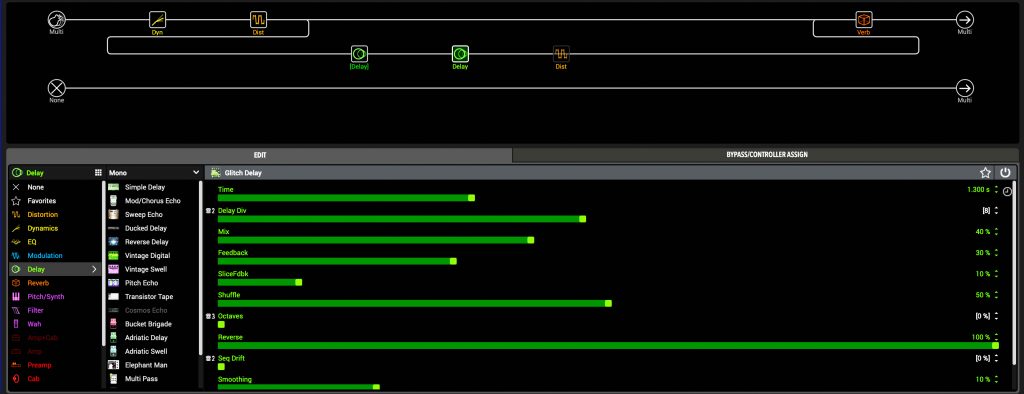
The Sarah “Noveller” Lipstate preset for HX/Helix processors.
Describe your tools and your approach to looping.
For a number of years, I used an Akai E1 Headrush and two Line 6 DL4 Delay Modelers in combination, which allowed me to have three independent, unsynchronized loops. I eventually replaced those pedals with a Boomerang III Phrase Sampler, which lets me record three loops using a single pedal, and the loops can either be unsynchronized in Free mode or synchronized if I want to have parts that lock together. I mostly used Free mode because I think it is so beautiful to have three loops of whatever length I want, interacting with each other in constantly changing ways. That always felt so amazing because I never wanted my music to sound stagnant. But having three synchronized loops is also really exciting to me because I’m still free to have loops of different lengths, as long as the lengths of loops two and three are some multiple or subdivision of the length of the master loop. So, as I have evolved, I’ve also become interested in writing music that is more rhythmic and structured than ambient.
It appears that you have the pedal dance pretty well choreographed in your live performances. To what extent does improvisation figure into the music?
Largely, everything is structured and there is kind of a choreography aspect as you put it. There are so many things going on that there has to be that overall structure for it to work. Of course, I’m constantly changing my pedalboards and so if I want to play a song that I originally did on an album from several years ago, I may not have the same pedals that I used for it available. For example, I just played my first Noveller show since 2019 and I decided to do a song from my Glacial Glow album that was released more than ten years ago. I had to find new ways to approach it using my current setup, and I also changed some aspects of the arrangement. The beginning was very structured and rehearsed, and the transition to the following song also has to be planned—but between those things it might veer off or morph into something different each time, so there is also space for improvisation.
When you perform live do you play through an amp?
Yes. The front of house engineer just mics it up.
A single amp or do you have two for stereo?
Sometimes stereo, but lately it’s been mono.
“Do Not Go Gentle Into That Good Night” from Iggy Pop’s Free album.
Is your creative process when recording different than when you are composing generally. Specifically, do you use the looper or just record performances directly?
I use the looper sometimes, but most often I just try to play the “looped” parts all the way through because I like the variation that inevitably happens and it also just sounds better. With the looper you are hearing the same cadence over and over again.
That also allows you to introduce intentional variations as well.
Exactly. I don’t record to a click and my playing isn’t perfect, so there are subtle tempo changes and other inconsistencies that make the music sound more alive. The looper is fine when I’m demoing things out, but I will go back and rerecord that stuff when I’m working on an album.
What is the single most important power tip you can offer to would-be loopists?
Oh man. I’d say they should give a lot of thought to what it is that they are hoping to achieve with a looper, because that will determine which one will be right for them. For example, when I am recording ambient loops, I really need to have the reverb tails and delay repeats continue when I close a loop, so they aren’t just chopped off abruptly. That involves pre-enabling overdubbing, which is apparently not something most manufacturers consider. I was able to program the Boomerang III to do it, but only after calling the company and asking whether it was possible.
You created an Artist Preset for the HX Effects pedal and you have also been using an HX Stomp amp and effects pedal. How have you integrated the HX Stomp into your work?
In two ways. I sometimes use it as a complete world unto itself when I’m recording and composing, including using the amp models. It’s really amazing to have so many possibilities in a single box. Live, because I have so much else in my signal chain, it just gets worked in as a multi-effects pedal and not so much for the amp modeling and stuff like that.
Lipstate loops then rocks out with Iggy Pop live at La Gaîté Lyrique, Paris, October 13, 2019.
You opened for Iggy Pop on his Post Pop Depression tour and then were invited to be a member of his band. But you also collaborated with him on three pieces that appear on his Free album, including the extraordinary “Do Not Go Gentle Into That Good Night,” in which he recites the Dylan Thomas poem of the same name. How did that happen to come about?
Iggy’s manger emailed me a rough recording of Iggy reciting the poem, and said something like “I wanted to send you this recording, this is for your ears only and if you’re interested and available, maybe you can build one of your guitar soundscapes around this, the spoken word track.” I launched myself completely into it and recorded what I thought was a really good cinematic soundscape to accompany the poem. I sent it to Iggy’s manager, who immediately responded, “This is wonderful, thank you,” and then nothing happened for months. Eventually I got another email saying that Iggy really loved the piece and asking whether I could do another one for what became “The Dawn.” His manager said, “Iggy particularly loved the guitar cover that you did of the theme music for John Carpenter’s The Thing, so maybe something in that vein?” I said alright, took that as my inspiration, composed a piece, and sent it off. Again, it was like I was just emailing music into the void. Then, many months later, his manager writes and tells me that not only is the record coming out, but that I have a producer credit, and I’m like, “Wait, what?” It was always presented as just something Iggy’s manger was doing on the down low, so it was a huge surprise and obviously really exciting to me to discover that they were using those pieces on an Iggy Pop record. So, that’s how it happened!
Main photo: Travis Shinn
Sarah with Iggy photo: Jim Dyson/Getty Images
Sarah surrounded by pedals photo: Priscilla C. Scott
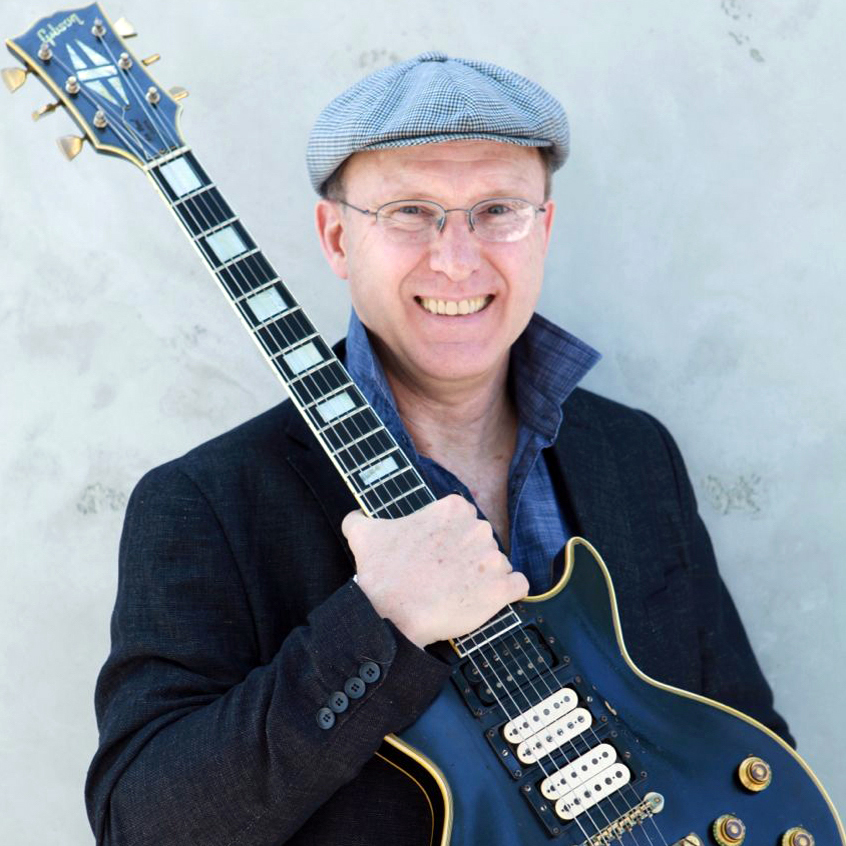
Barry Cleveland is a Los Angeles-based guitarist, recordist, composer, music journalist, and editor-in-chief of Model Citizens and The Lodge, as well as the author of Joe Meek’s Bold Techniques and a contributing author to Stompbox: 100 Pedals of the World’s Greatest Guitarists. Cleveland also served as an editor at Guitar Player magazine for 12 years and is currently the Marketing Communications Manager at Yamaha Guitar Group. barrycleveland.com
Related posts
Leave a Reply
You must be logged in to post a comment.
By submitting your details you are giving Yamaha Guitar Group informed consent to send you a video series on the Line 6 HX Stomp. We will only send you relevant information. We will never sell your information to any third parties. You can, of course, unsubscribe at any time. View our full privacy policy

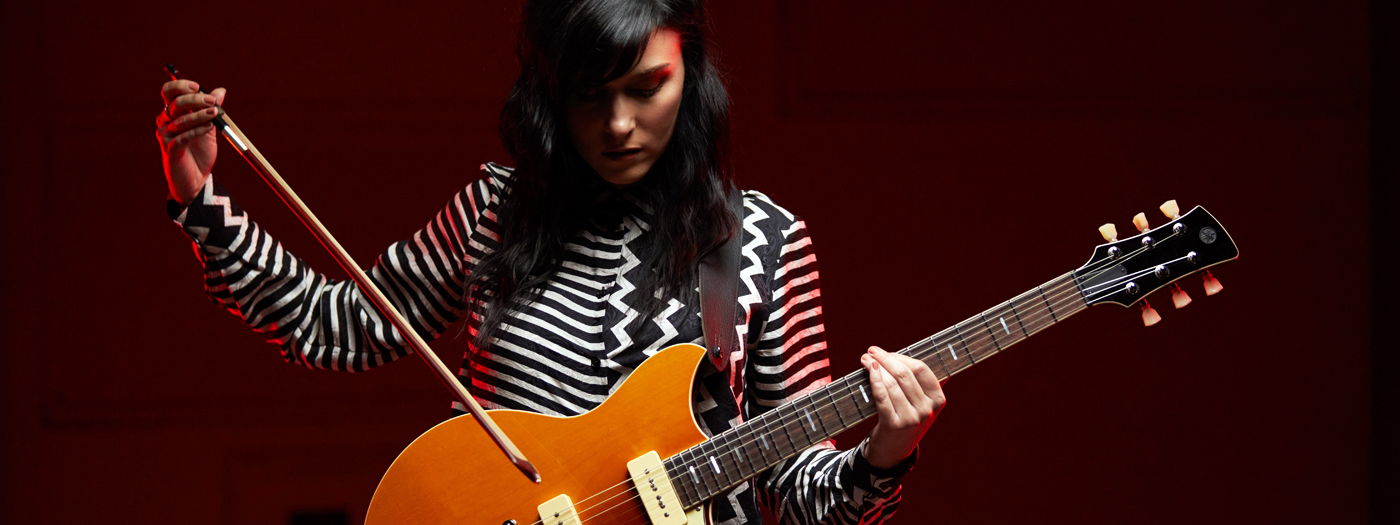
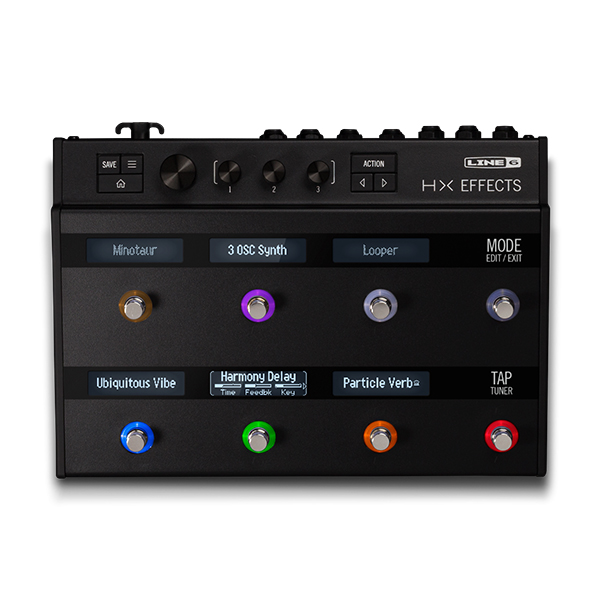
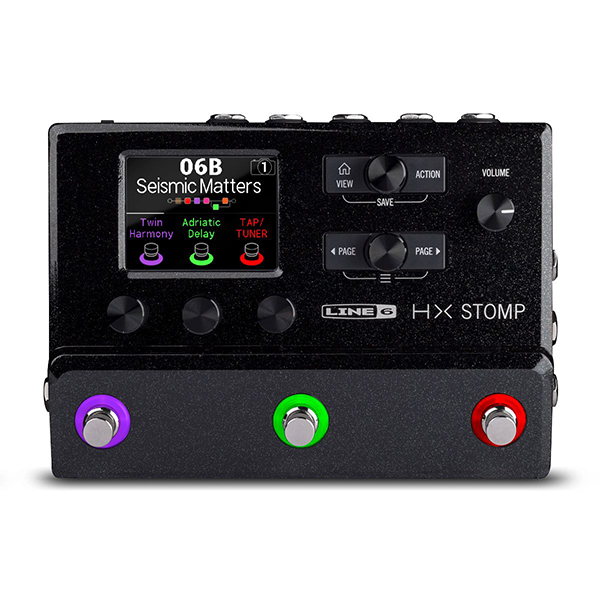
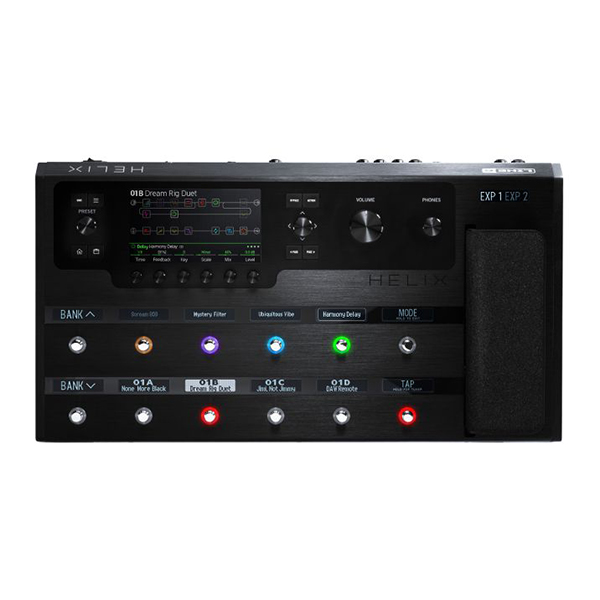
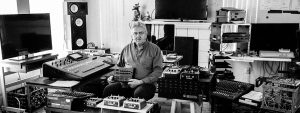
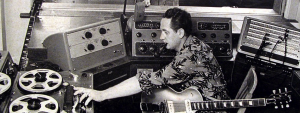
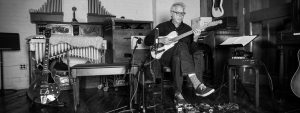
Great interview, Barry!
Thank you, Dave!
Pretty girls get away with murder.